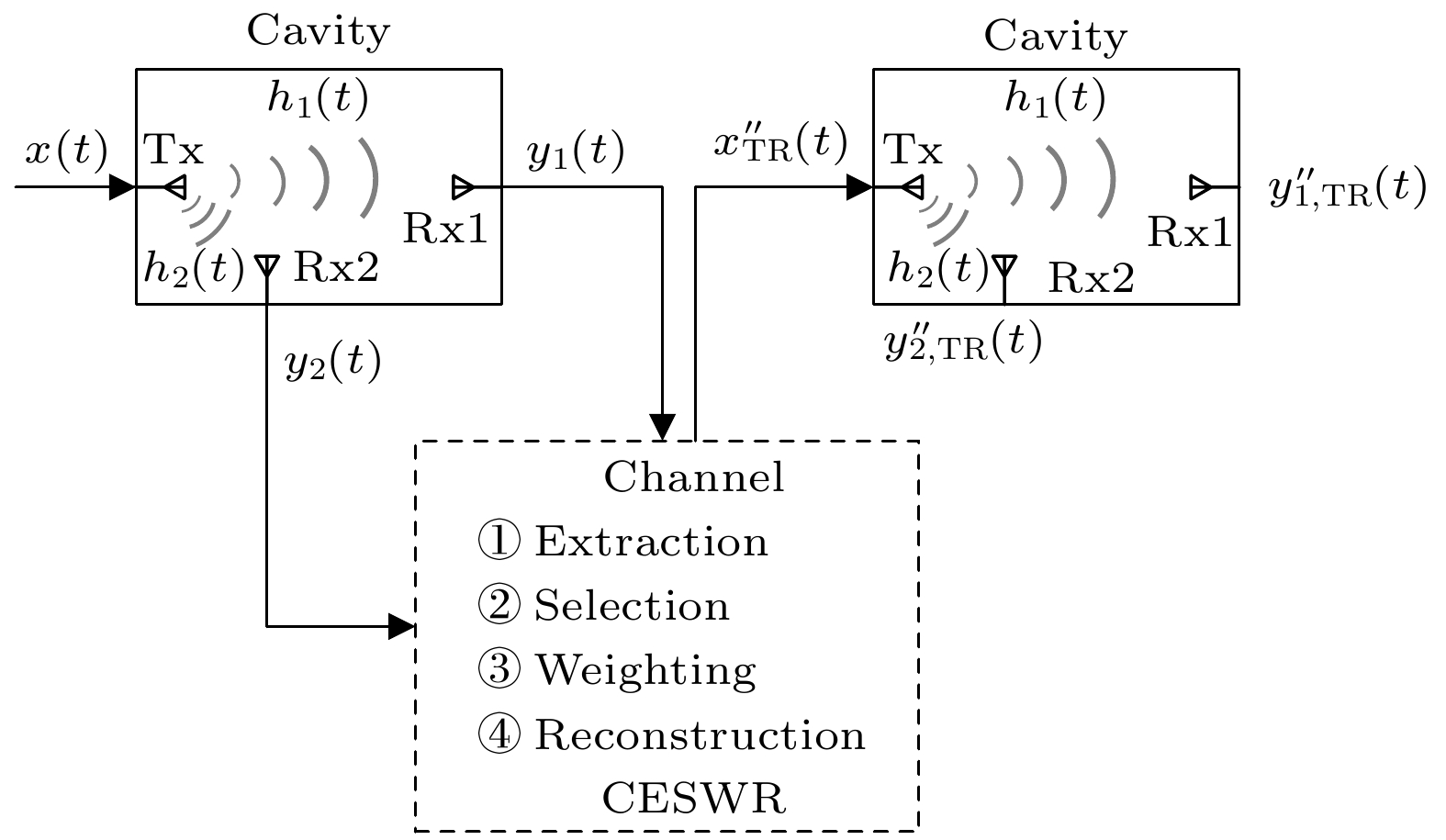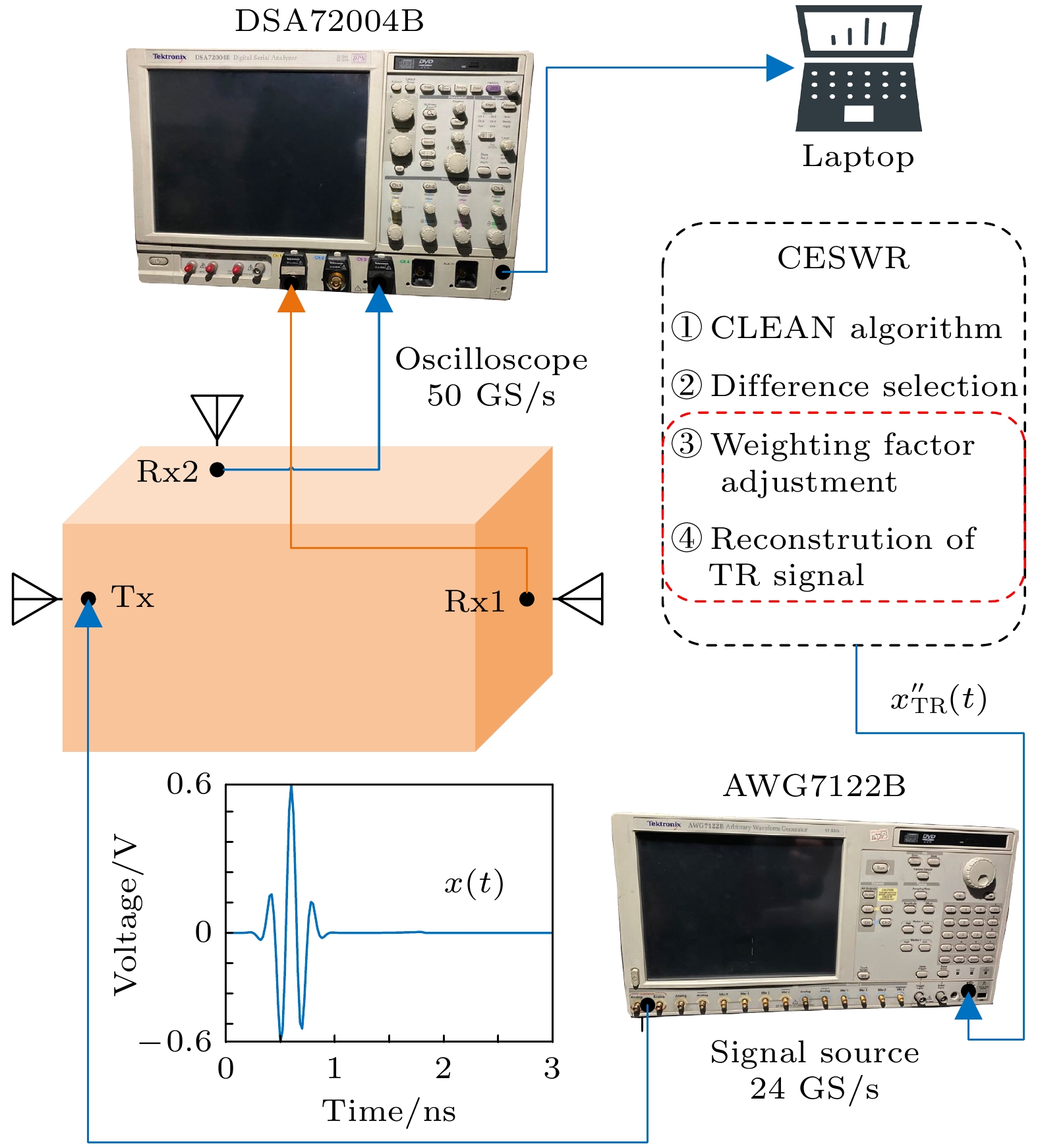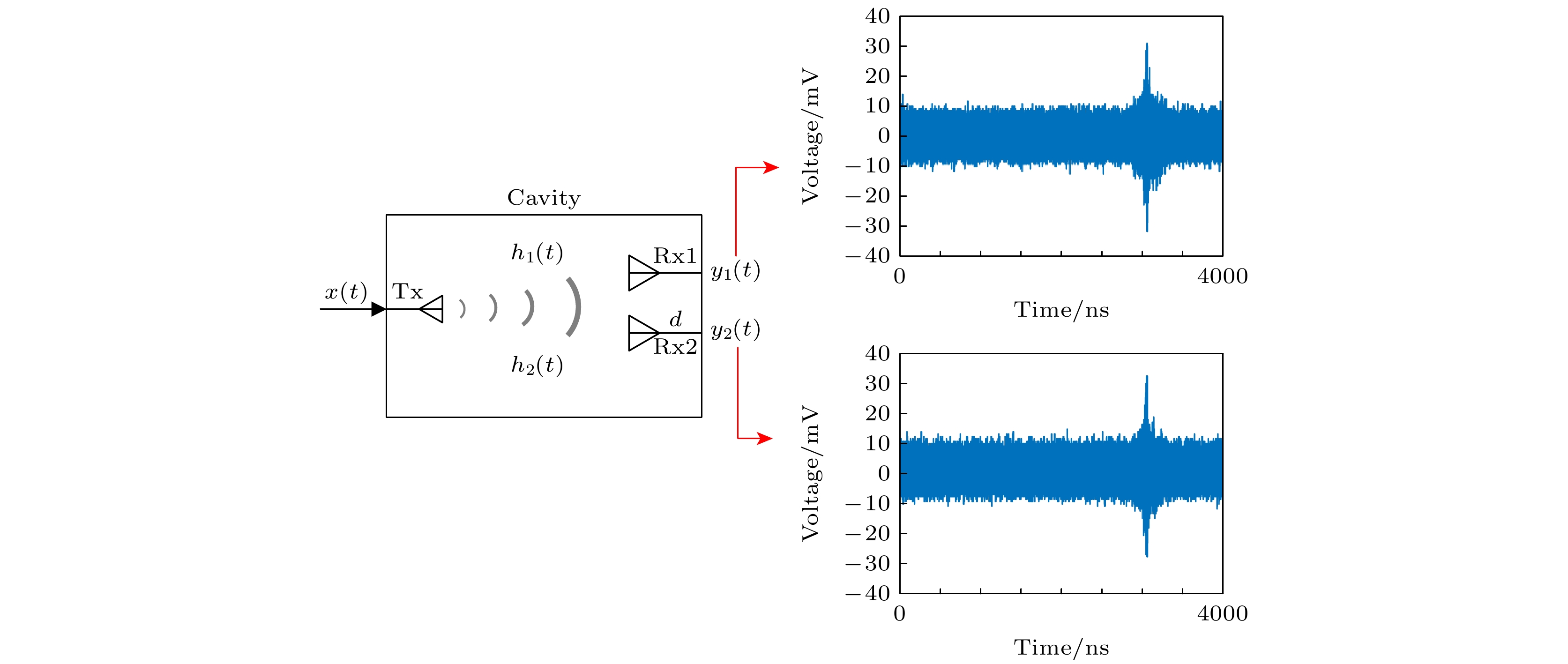-
Achieving tunable focus of electromagnetic field energy at multiple target points is a critical challenge in the wireless power transfer (WPT) domain. In order to solve this problem, some techniques such as optimal constrained power focusing (OCPF) and time reversal (TR) have been proposed. The former presents limited practical applicability while the latter is noteworthy for its adaptive spatiotemporal synchronous focusing characteristics. However, the time reversal mirror (TRM) method necessitates intricate pretesting and has highly complex systems. In this study, we introduce a novel channel processing method, named channel extraction, selection, weighting, and reconstruction (CESWR), to attain balanced power distribution for multiple users, featuring low complexity, high computability, and rapid convergence. Unlike the traditional TR approach, our proposed method, based on channel correlation considerations, filters the channel impulse response (CIR) for multiple targets, dividing them into distinct characteristic and similar components for each target. This method ensures focused generation at both receiving ends while facilitating high-precision regulation of the peak voltage of the received signal. Furthermore, this study implements a rigorous examination of the linearity intrinsic to the proposed method, explicating a singular correspondence between the tuning of theoretical weights and the resultant outcomes. In order to verify the efficacy of this method, we construct a single-input multiple-output time-reversal cavity (SIMO-TRC) system. Subsequent experiments conducted for both loosely and tightly correlated models, provide invaluable insights. Evidently, in the loosely correlated model, the CESWR method exhibits proficiency in attaining a peak voltage ratio (PVR) of nearly 1.00 at the two receivers, with a minuscule numerical discrepancy of merely
$8 \times {10^{ - 6}}$ mV. In stark contrast, under the tightly correlated model, the CESWR method demonstrates an enhanced ability to differentiate between two targets, thus offering a noticeable improvement over the classic single-target TR method.-
Keywords:
- time-reversal /
- channel processing /
- multi-target focusing
[1] Wang B, Wu Y, Han F, Yang Y H, Liu K R 2011 IEEE J. Sel. Areas Commun. 29 1698
 Google Scholar
Google Scholar
[2] Han F, Yang Y H, Wang B, Wu Y, Liu K R 2012 IEEE Global Telecommunications Conference-GLOBECOM 2011 Houston, TX, USA, December 5–9, 2011 p1
[3] Nguyen H T, Andersen J B, Pedersen G F, Kyritsi P, Eggers P C 2006 IEEE Trans. Wireless Commun. 5 2242
 Google Scholar
Google Scholar
[4] Zhao D, Zhu M 2006 IEEE Antennas Wirel. Propag. Lett. 15 1739
 Google Scholar
Google Scholar
[5] Bellizzi G G, Bevacqua M T, Crocco L, Isernia T 2018 IEEE Trans. Antennas Propag. 66 4380
 Google Scholar
Google Scholar
[6] Li B, Liu S, Zhang H L, Hu B J, Zhao D, Huang Y 2019 IEEE Access 7 114897
 Google Scholar
Google Scholar
[7] Bellizzi G G, Iero D A, Crocco L, Isernia T 2018 IEEE Antennas Wirel. Propag. Lett. 17 360
 Google Scholar
Google Scholar
[8] Iero D A, Crocco L, Isernia T 2013 IEEE Trans. Antennas Propag. 62 814
 Google Scholar
Google Scholar
[9] Lerosey G, De Rosny J, Tourin A, Derode A, Montaldo G, Fink M 2004 Phys. Rev. Lett. 92 193904
 Google Scholar
Google Scholar
[10] Carminati R, Pierrat R, De Rosny J, Fink M 2007 Opt. Lett. 32 3107
 Google Scholar
Google Scholar
[11] Hong S K, Lathrop E, Mendez V M, Kim J 2015 Prog. Electromagn. Res. 153 113
 Google Scholar
Google Scholar
[12] Hong S, Park H 2018 Electron. Lett. 54 768
 Google Scholar
Google Scholar
[13] Drikas Z B, Addissie B D, Mendez V M, Raman S 2020 IEEE Trans. Microwave Theory Tech. 68 3355
 Google Scholar
Google Scholar
[14] Li B, Zhang Q, Zhao D, Yang Y 2022 Asia-Pacific International Symposium on Electromagnetic Compatibility (APEMC) Beijing, China, September 1–4, 2022 p356
[15] Drikas Z B, Addissie B D, Mendez V M, Raman S 2021 IEEE Microwave Wireless Compon. Lett. 32 177
 Google Scholar
Google Scholar
[16] Wang K, Shao W, Ou H, Wang B Z 2017 IEEE Antennas Wirel. Propag. Lett. 16 2828
 Google Scholar
Google Scholar
[17] Razzaghi R, Lugrin G, Manesh H, Romero C, Paolone M, Rachidi F 2013 IEEE Trans. Power Delivery 28 1663
 Google Scholar
Google Scholar
[18] Codino A, Wang Z, Razzaghi R, Paolone M, Rachidi F 2017 IEEE Trans. Electromagn. Compat. 59 1601
 Google Scholar
Google Scholar
[19] Sun J, Yang Q, Cui H, Ran J, Liu H 2021 IEEE Trans. Electromagn. Compat. 63 1921
 Google Scholar
Google Scholar
[20] Ding S, Fang Y, Zhu J F, Yang Y, Wang B Z 2019 IEEE Trans. Antennas Propag. 67 1386
 Google Scholar
Google Scholar
[21] Ibrahim R, Voyer D, Bréard A, Huillery J, Vollaire C, Allard B, Zaatar Y 2016 IEEE Trans. Microwave Theory Tech. 64 2159
 Google Scholar
Google Scholar
[22] 张知原, 李冰, 刘仕奇, 张洪林, 胡斌杰, 赵德双, 王楚楠 2022 物理学报 71 014101
 Google Scholar
Google Scholar
Zhang Z Y, Li B, Liu S Q, Zhang H L, Hu B J, Zhao D S, Wang C N 2022 Acta Phys. Sin. 71 014101
 Google Scholar
Google Scholar
[23] Derode A, Tourin A, Fink M 1999 J. Appl. Phys. 85 6343
 Google Scholar
Google Scholar
[24] 陆希成, 邱扬, 田锦, 汪海波, 江凌, 陈鑫 2022 物理学报 71 024101
 Google Scholar
Google Scholar
Lu X C, Qiu Y, Tian J, Wang H B, Jiang L, Chen X 2022 Acta Phys. Sin. 71 024101
 Google Scholar
Google Scholar
[25] Cramer R M, Scholtz R A, Win M Z 2002 IEEE Trans. Antennas Propag. 50 561
 Google Scholar
Google Scholar
[26] Lerosey G, De Rosny J, Tourin A, Fink M 2007 Science 315 1120
 Google Scholar
Google Scholar
-
图 4 信道提取和筛选后的结果 (a) Rx1的接收信号和Rx2的接收信号; (b) 信道提取结果(RMSE = 0.2%); (c) 信道筛选后Rx1和Rx2各自的特征部分; (d) 信道筛选后的相似部分
Figure 4. Receive signals after transmitting the pulse and processing results: (a) Receive signals of Rx1 plotted in blue and Rx2 plotted in yellow; (b) channel extraction results (RMSE = 0.2%); (c) characteristic parts after channel selecting; (d) the similar part after channel selecting.
表 1 不同的加权系数对应的峰值电压比
Table 1. Peak voltage ratio of different coefficiesnts
峰值电压比 α β 1.000 0.20 0.50 1.381 0.15 0.50 0.696 0.25 0.50 0.766 0.20 0.40 1.262 0.20 0.60 0.367 1.00 1.00 表 2 强相关实验峰值电压比和加权系数结果对比
Table 2. Comparison of peak voltage ratio and coefficients in tight-correlation experiments.
峰值电压比 α β 3.741 0 1.00 0.466 1.00 0 3.812 0.10 0.90 3.816 0.08 0.92 0.423 0.90 0.10 0.418 0.92 0.08 -
[1] Wang B, Wu Y, Han F, Yang Y H, Liu K R 2011 IEEE J. Sel. Areas Commun. 29 1698
 Google Scholar
Google Scholar
[2] Han F, Yang Y H, Wang B, Wu Y, Liu K R 2012 IEEE Global Telecommunications Conference-GLOBECOM 2011 Houston, TX, USA, December 5–9, 2011 p1
[3] Nguyen H T, Andersen J B, Pedersen G F, Kyritsi P, Eggers P C 2006 IEEE Trans. Wireless Commun. 5 2242
 Google Scholar
Google Scholar
[4] Zhao D, Zhu M 2006 IEEE Antennas Wirel. Propag. Lett. 15 1739
 Google Scholar
Google Scholar
[5] Bellizzi G G, Bevacqua M T, Crocco L, Isernia T 2018 IEEE Trans. Antennas Propag. 66 4380
 Google Scholar
Google Scholar
[6] Li B, Liu S, Zhang H L, Hu B J, Zhao D, Huang Y 2019 IEEE Access 7 114897
 Google Scholar
Google Scholar
[7] Bellizzi G G, Iero D A, Crocco L, Isernia T 2018 IEEE Antennas Wirel. Propag. Lett. 17 360
 Google Scholar
Google Scholar
[8] Iero D A, Crocco L, Isernia T 2013 IEEE Trans. Antennas Propag. 62 814
 Google Scholar
Google Scholar
[9] Lerosey G, De Rosny J, Tourin A, Derode A, Montaldo G, Fink M 2004 Phys. Rev. Lett. 92 193904
 Google Scholar
Google Scholar
[10] Carminati R, Pierrat R, De Rosny J, Fink M 2007 Opt. Lett. 32 3107
 Google Scholar
Google Scholar
[11] Hong S K, Lathrop E, Mendez V M, Kim J 2015 Prog. Electromagn. Res. 153 113
 Google Scholar
Google Scholar
[12] Hong S, Park H 2018 Electron. Lett. 54 768
 Google Scholar
Google Scholar
[13] Drikas Z B, Addissie B D, Mendez V M, Raman S 2020 IEEE Trans. Microwave Theory Tech. 68 3355
 Google Scholar
Google Scholar
[14] Li B, Zhang Q, Zhao D, Yang Y 2022 Asia-Pacific International Symposium on Electromagnetic Compatibility (APEMC) Beijing, China, September 1–4, 2022 p356
[15] Drikas Z B, Addissie B D, Mendez V M, Raman S 2021 IEEE Microwave Wireless Compon. Lett. 32 177
 Google Scholar
Google Scholar
[16] Wang K, Shao W, Ou H, Wang B Z 2017 IEEE Antennas Wirel. Propag. Lett. 16 2828
 Google Scholar
Google Scholar
[17] Razzaghi R, Lugrin G, Manesh H, Romero C, Paolone M, Rachidi F 2013 IEEE Trans. Power Delivery 28 1663
 Google Scholar
Google Scholar
[18] Codino A, Wang Z, Razzaghi R, Paolone M, Rachidi F 2017 IEEE Trans. Electromagn. Compat. 59 1601
 Google Scholar
Google Scholar
[19] Sun J, Yang Q, Cui H, Ran J, Liu H 2021 IEEE Trans. Electromagn. Compat. 63 1921
 Google Scholar
Google Scholar
[20] Ding S, Fang Y, Zhu J F, Yang Y, Wang B Z 2019 IEEE Trans. Antennas Propag. 67 1386
 Google Scholar
Google Scholar
[21] Ibrahim R, Voyer D, Bréard A, Huillery J, Vollaire C, Allard B, Zaatar Y 2016 IEEE Trans. Microwave Theory Tech. 64 2159
 Google Scholar
Google Scholar
[22] 张知原, 李冰, 刘仕奇, 张洪林, 胡斌杰, 赵德双, 王楚楠 2022 物理学报 71 014101
 Google Scholar
Google Scholar
Zhang Z Y, Li B, Liu S Q, Zhang H L, Hu B J, Zhao D S, Wang C N 2022 Acta Phys. Sin. 71 014101
 Google Scholar
Google Scholar
[23] Derode A, Tourin A, Fink M 1999 J. Appl. Phys. 85 6343
 Google Scholar
Google Scholar
[24] 陆希成, 邱扬, 田锦, 汪海波, 江凌, 陈鑫 2022 物理学报 71 024101
 Google Scholar
Google Scholar
Lu X C, Qiu Y, Tian J, Wang H B, Jiang L, Chen X 2022 Acta Phys. Sin. 71 024101
 Google Scholar
Google Scholar
[25] Cramer R M, Scholtz R A, Win M Z 2002 IEEE Trans. Antennas Propag. 50 561
 Google Scholar
Google Scholar
[26] Lerosey G, De Rosny J, Tourin A, Fink M 2007 Science 315 1120
 Google Scholar
Google Scholar
Catalog
Metrics
- Abstract views: 5104
- PDF Downloads: 132
- Cited By: 0
















 DownLoad:
DownLoad:







